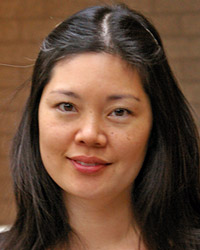Introducing: Carolyn Nakamura
Carolyn Nakamura works as a postdoctoral researcher on the profile area Global Interactions.
 Born and raised in northern California, I first began my studies in chemistry at Reed College in Portland, Oregon where I graduated with a BA in Chemistry in 1995. After working in a neuroscience lab at the Portland VA Medical Center for two years, I felt that the bench work and positivism of laboratory sciences did not quite satisfy my intellectual interests (although I still maintain a love for chemistry). So I decided to pursue postgraduate studies in a new field. I eventually settled on archaeology and started a PhD in the anthropology department at Columbia University in New York. Initially, I utilized my science background and worked on projects in ancient materials analysis; however, my interests quickly turned towards archaeological theory and sociocultural anthropology. Although I set out to study South Asian archaeology, I eventually specialized in the ancient Near East.
Born and raised in northern California, I first began my studies in chemistry at Reed College in Portland, Oregon where I graduated with a BA in Chemistry in 1995. After working in a neuroscience lab at the Portland VA Medical Center for two years, I felt that the bench work and positivism of laboratory sciences did not quite satisfy my intellectual interests (although I still maintain a love for chemistry). So I decided to pursue postgraduate studies in a new field. I eventually settled on archaeology and started a PhD in the anthropology department at Columbia University in New York. Initially, I utilized my science background and worked on projects in ancient materials analysis; however, my interests quickly turned towards archaeological theory and sociocultural anthropology. Although I set out to study South Asian archaeology, I eventually specialized in the ancient Near East.
With the help of research grants and fellowships from the Wenner-Gren Foundation, Columbia University, and the Getty Research Institute, I completed my dissertation titled, The matter of magic: Material figures of memory and protection in Neo-Assyrian apotropaic figurine rituals (first millennium BC). In 2004, I joined the Çatalhöyük Research Project in Turkey as a figurine specialist. This work has now expanded to research on burial goods, magic and database planning. I have authored and co-authored papers that have appeared in World Archaeology, the Cambridge Archaeological Journal, the Journal of Archaeological Method and Theory and several edited volumes.
Previous to Leiden, I was a lecturer at Stanford University in the Anthropology department from 2008-2010, where I taught classes on magic, science and religion, urbanism, material culture, archaeological theory and global heritage.
Finally, during my five year tenure as the postdoc coordinator for the Global Interactions profile area, I will continue research I began in 2009 on emerging heritage practices in Mumbai, India. Suburban Buddhist and Hindu rock-cut caves and colonial forts in Mumbai are hosts to a convergence of forms and activities: vernacular habitats (or informal communities), vegetation and wildlife, migrant flows, and places of worship. A new state interest in heritage preservation now seeks to evict and prevent many of these kinetic activities in and around historical sites, reenacting a colonial project, as it were. Given the divergent desires of various stakeholders (local residents, the state, the heterogeneous Mumbai public), these caves and forts locate complex fields of contest and negotiation. In particular, my research will critically examine the problematic application of static heritage notions of ‘value’ and ‘significance’ in the dynamic and fluid landscape of Mumbai, and how the ‘reclamation’ of heritage at these sites activates particular networks of power. This work will also pursue an alternative account of heritage, one that embraces the living histories of the sites and their residents.
